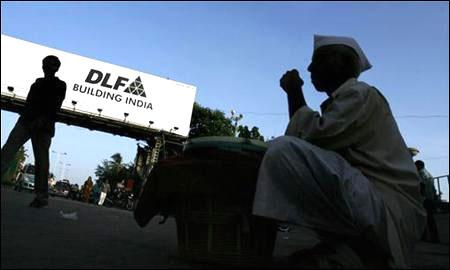Photographs: Arko Datta/Reuters Shishir Asthana
The company will have 9 mn sq ft of property for sale in the second half of 2012-13, which is three times what it sold in the first half.
The DLF stock fell momentarily after the company announced its results, but recovered strongly on hopes that the worst is behind it. After a 63 per cent drop in net profit for September 2012 on a year on year basis, DLF shares opened lower on muhurat trading day but regained lost ground after the initial dip.
On Thursday, it closed 3.2 per cent higher at Rs 209.30. The recovery came on a day when the broad indices where trading over 0.7 per cent lower.
It is said that when a stock stops reacting to any negative news, it's time to invest. DLF has had more than a fair share of negative news, a major part of it being its own doing. However, the stock has show resilience in the face of news and various allegations.
No doubt, the company was hit by sectoral headwinds, which prevented a recovery. DLF has been straddled with huge debt and in order to get rid of it, the company is looking at selling non-core assets. Why should shareholders' funds be invested in these non-core businesses in the first place is a question few analysts have asked.
But the question of why land was sold at a lower price to Robert Vadra and bought back again at a higher price from him within months at the cost of shareholders' and banks' money is a question that remains unanswered.
Click on NEXT for more...
Is the worst really over for DLF?
Photographs: Punit Paranjpe/Reuters
In its analyst presentation, DLF has boldly claimed that "Worst is behind us!". The presentation adds, "But for any unforeseen circumstances, the company is now well positioned to 'take-off' as it moves towards new launches in excess of 9 million square feet in the second half of FY13."
In the first half of the current fiscal DLF managed to sell only 2.96 million sq ft.
What DLF is trying to say through its presentation is that three times as much property will be available for sale in the second half as compared to the first half. Fair enough, but where are the buyers?
DLF plans to flood the Gurgaon real estate market with 8.5 million sq ft of real estate (luxury premium group housing) in the second half and further 1 million sq ft each in Bangalore and Lucknow.
A report in The Times of India says that while new launches by various players have increased sharply, the absorption rate has failed to keep pace.
In fact, absorption rates have dropped despite new launches, signalling fewer buyers for the supply hitting the market.
Click on NEXT for more...
Is the worst really over for DLF?
Photographs: Adnan Abidi/Reuters
Unlike real estate, where the company will face difficulty in finding buyers, it does not seem so in the equity markets, where investors seem to have bought their side of the story.
One of the main reasons why DLF shares have not fallen despite the bombardment of bad news is that most of the shares of the company are owned by the promoters. Nearly 78.58 per cent of the shareholding is held by the promoters, while 15.87 per cent is held by foreign institution investors who for some reason are holding on to the shares in spite of all negative factors.
Curiously, nearly 10 per cent of FII shareholding increased on account of promoters reducing their stake from 88.55 per cent to 78.65 per cent in June 2009.
DLF now plans to reduce its stake further to below 75 per cent levels to meet the listing guidelines. But unlike in the past where it sold its stake to FIIs, the company now plans to issue fresh shares. And in order to issue fresh shares it would either need a good market or a higher share price.
Markets do not seem to be going anywhere in a hurry, but the company's share price should rise if the management needs a good price for its dilution.
DLF has given the market an optimistic story once again, but will there be takers?





article